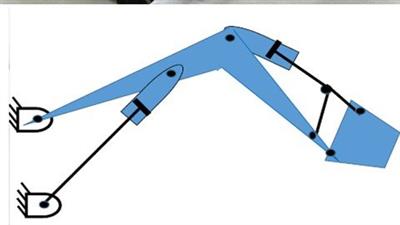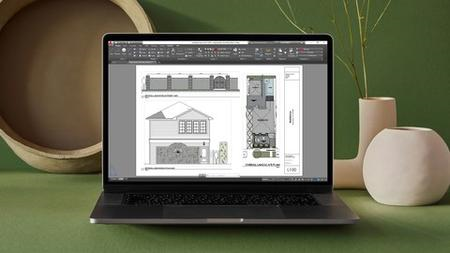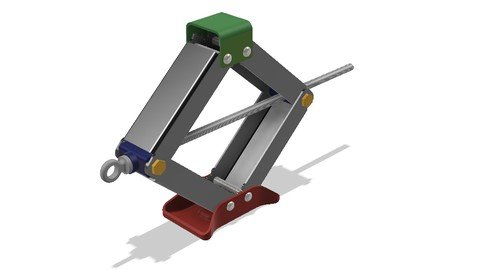
Basics Of Mechanism Design & Analysis For Mechanical Design
Posted on 07 Jul 00:31 | by huayting | 23 views

Basics Of Mechanism Design & Analysis For Mechanical Design
Last updated 2/2022
MP4 | Video: h264, 1280x720 | Audio: AAC, 44.1 KHz
Language: English | Size: 1.44 GB | Duration: 4h 58m
Learn about how to design and analyze planar mechanisms with case studies for mechanical engineers
What you'll learn
The Design process for mechanism design in designing mechanical systems
Basics of Kinematic concepts - Degrees of freedom, mobility, Kinematic inversions etc
Position Analysis - Loop closure equations, Finding positions of points
Velocity analysis of Simple mechanisms
Acceleration analysis
Static Force analysis
Dynamic Force , Inertia force analysis
Case studies on actual applications of mechanism design principles
Requirements
Basic understanding of mechanics
Background on Math concepts like Vectors , Algebra, Trigonometry
Description
Mechanisms and structures are fundamental elements of any mechanical design.In this course we will learn in depth about the fundamentals of mechanisms , the study of their motion and the application to actual product design The following topics will be covered :An overview of the mechanical design process and where mechanism design fits into the larger pictureWhat are functional requirements in product or systems design and the many functional keywordsA general approach in designing mechanisms from scratchThe difference between Analysis and SynthesisConcept of Degrees of FreedomKinematic pairs and joints and their typesPlanar and Spatial mechanisms introuctionMobility Kutzbach criteria and examplesCriteria for spatial mechanism with examplesKinematic inversionsGrashof criteria for 4 link mechanismsBasics of position vectorsLoop closure equationsFinding position of a point on linkVelocity analysis BasicsVelocity analysis of 4 link mechanism and slider crank mechanismsFinding velocity of any point on the linksAcceleration analysis introductionProblems in acceleration analysis - How to find absolute accelerations for any point on the linkStatic Force analysisDynamic force analysis and concepts of Inertia , D'alemberts principle appliedProblem in dynamic force analysisCase studies in application of mechanism design to product design or systems design This course is a deep dive in the world of mechanisms and the main purpose is to form a strong foundation to apply in actual engineering problems and go towards advanced design Learning Outcomes AimedDevelop a strong conceptual understanding of designing mechanism from fundamentalsAbility to develop analyses of mechanisms and understand the motion thoroughlyDevelop understanding of the design process for new design
Overview
Section 1: Introduction & fundamentals
Lecture 1 Introduction to course
Lecture 2 Overview of design process
Lecture 3 Breaking down functional requirements - mechanism design
Lecture 4 General approach in mechanism design
Lecture 5 Analysis and Synthesis
Lecture 6 Degrees of freedom concept
Lecture 7 Kinematic Pairs
Lecture 8 Mechanism and Kinematic chains
Lecture 9 Assumption of rigidity
Lecture 10 Planar and Spatial mechanism
Section 2: Mobility
Lecture 11 Mobility Criteria - Kutzbach criteria for Planar mechanism
Lecture 12 Application of Mobility criteria - Examples
Lecture 13 Exception to Kutzbach criteria
Lecture 14 Criteria for Spatial mechanism
Lecture 15 Kinematic Inversions - Slider crank and 4 bar
Lecture 16 Grashof Criteria
Section 3: Position analysis
Lecture 17 Position analysis basics of vectors
Lecture 18 Loop closure equation - 4 bar link
Lecture 19 Loop closure equation Slider crank
Lecture 20 Finding absolute position of a point on coupler of 4 bar link mechanism
Section 4: Velocity analysis
Lecture 21 Velocity analysis- Basics
Lecture 22 Velocity analysis of a coupler link of 4 Bar mechanism
Lecture 23 Velocity analysis problem 1 part 1
Lecture 24 Velocity analysis problem 1 part 2
Lecture 25 Velocity Analysis Problem 2
Section 5: Acceleration analysis
Lecture 26 Basics of Acceleration
Lecture 27 Problem 1 - Acceleration analysis
Lecture 28 Problem 2 - Acceleration Analysis Part 1
Lecture 29 Problem 2 - Acceleration Analysis Part 2
Section 6: Force analysis
Lecture 30 Force analysis Introduction
Lecture 31 Static Force Analysis -4 bar mechanism
Lecture 32 Static Force Analysis - Slider Crank mechanism
Lecture 33 Dynamic Force analysis- Inertia and D'alemberts principle
Lecture 34 Double Slider problem- Find Inertia
Section 7: Design case studies
Lecture 35 Case study 1 - Retractable Seat
Lecture 36 Case study 2 - Window opening mechanism
Lecture 37 Case study 3 - High camber suspension system
Lecture 38 Case study 4 - Windshield Wiper system
Lecture 39 Case study 5 - Press Brake shear for cutting sheets
Section 8: Test your knowledge
Design engineers who regularly apply or want to apply engineering principles on product and systems design,Engineering students
https://www.udemy.com/course/basics-of-mechanism-design-analysis-for-mechanical-design/PLEASE SUPPORT ME BY CLICK ONE OF MY LINKS IF YOU WANT BUYING OR EXTENDING YOUR ACCOUNT
https://nitro.download/view/0DDC535F467C839/Basics_of_Mechanism_design_%26_analysis_for_Mechanical_design.part1.rar
https://nitro.download/view/8B76ABECBE17AFE/Basics_of_Mechanism_design_%26_analysis_for_Mechanical_design.part2.rar
https://nitro.download/view/0DDC535F467C839/Basics_of_Mechanism_design_%26_analysis_for_Mechanical_design.part1.rar
https://nitro.download/view/8B76ABECBE17AFE/Basics_of_Mechanism_design_%26_analysis_for_Mechanical_design.part2.rar
https://rapidgator.net/file/3a9cb204cf453026014c7f5a435a479a/Basics_of_Mechanism_design_&_analysis_for_Mechanical_design.part1.rar.html
https://rapidgator.net/file/695d28f6d051aec38b7d3b6fd7aa38d8/Basics_of_Mechanism_design_&_analysis_for_Mechanical_design.part2.rar.html
https://uploadgig.com/file/download/6B205402Ed0c478c/Basics_of_Mechanism_design__analysis_for_Mechanical_design.part1.rar
https://uploadgig.com/file/download/d9b1Ee5790508912/Basics_of_Mechanism_design__analysis_for_Mechanical_design.part2.rar
Related News
System Comment
Information
 Users of Visitor are not allowed to comment this publication.
Users of Visitor are not allowed to comment this publication.
Facebook Comment
Member Area
Top News



